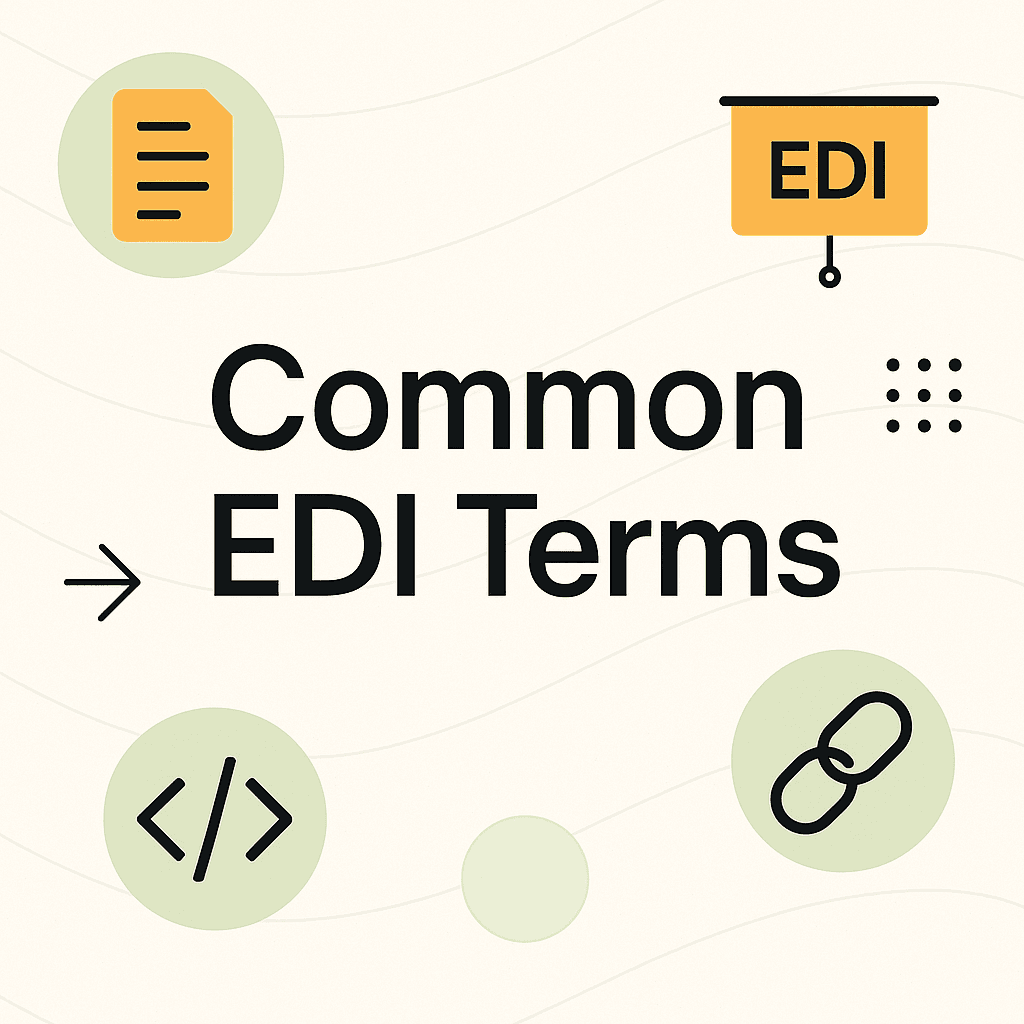Electronic Data Interchange (EDI) is the standard method businesses use to exchange documents digitally, and understanding key EDI terms helps teams communicate clearly and stay compliant.
Understanding the language of Electronic Data Interchange (EDI) is essential for anyone working in supply chain, retail, logistics, or B2B integrations. This guide breaks down the most common EDI terms and definitions to help you navigate EDI documents, transactions, and systems with confidence. Whether you’re new to EDI or modernizing your current setup, these definitions will help you make sense of the terminology you encounter daily.
Common EDI Terms and Definitions
Term | Definition |
|---|---|
EDI (Electronic Data Interchange) | The electronic exchange of standardized business documents between trading partners. Learn more. |
EDI Standards | The formatting rules and structures that define how EDI documents are transmitted, such as ANSI X12 or EDIFACT. Read more. |
ANSI X12 | The primary EDI standard used in North America, developed by the Accredited Standards Committee (ASC X12). Explore ANSI standards. |
EDIFACT | A global EDI standard maintained by the United Nations for international business communication. |
EDI Transaction Set | A predefined document type used to exchange specific information, such as a purchase order (850) or invoice (810). See EDI types. |
ISA ID | The unique identifier for each EDI partner, used in the interchange header to route messages. Learn more. |
EDI Mapping | The process of aligning data fields between internal systems and EDI documents. Best practices. |
EDI Integration | Connecting EDI software directly with your ERP, WMS, or TMS to automate data flow. See integration examples. |
850 Purchase Order | The EDI document used to place an order from a buyer to a supplier. |
856 Advance Ship Notice (ASN) | The EDI document that provides shipment details before goods arrive. Learn how ASNs work. |
810 Invoice | The EDI document sent by suppliers to request payment for goods or services delivered. Read about EDI payments. |
GS1-128 Label | A standardized shipping label format that includes barcode data for tracking and compliance. See retailer label templates. |
Trading Partner | Any business entity that exchanges EDI documents electronically, such as retailers, suppliers, or 3PLs. Discover how to onboard partners faster. |
EDI Acknowledgment (997) | A confirmation that an EDI transmission was received successfully. |
EDI Compliance | The process of ensuring that EDI messages meet a trading partner’s format and validation requirements. |
EDI Platform | A centralized system for managing, translating, and transmitting EDI documents. Learn about modern EDI platforms. |
API Integration | Connecting systems via APIs to share data in real time, often complementing or replacing EDI. Compare EDI and API. |
Why Learning EDI Terminology Matters
The world of EDI is filled with acronyms and document codes that can feel confusing at first. But these terms represent a universal language that keeps supply chains running smoothly. Knowing how to interpret them helps your team troubleshoot faster, improve partner communication, and avoid chargebacks from compliance errors.
If you’re transitioning from a legacy EDI system to a modern cloud platform, understanding these terms is the first step toward reducing manual work and improving data accuracy. Read more about this in EDI Modernization: Why It Matters.
Core EDI Document Types
EDI transactions are categorized by type, each serving a specific purpose in the business cycle:
850 Purchase Order: Initiates the buying process between a retailer and supplier.
855 Purchase Order Acknowledgment: Confirms receipt and acceptance of an order.
856 Advance Ship Notice (ASN): Communicates shipment details before delivery.
810 Invoice: Requests payment after goods are delivered.
846 Inventory Inquiry/Advice: Shares stock availability.
997 Functional Acknowledgment: Confirms successful EDI transmission.Each document type follows a specific format defined by EDI standards such as ANSI X12 or EDIFACT, ensuring data consistency across industries.
Learn more about the types of EDI transactions and how they automate core business processes.
EDI Standards and Protocols
EDI communication depends on global standards that define how data is structured and exchanged. The most common include:
ANSI X12: Primarily used in North America.
EDIFACT: Widely used in Europe and international trade.
TRADACOMS: Used in the UK retail sector.
ODETTE: Common in the automotive industry.Data transmission typically occurs over secure protocols such as AS2, SFTP, or API-based exchanges in modern systems. Read more about this in EDI Standards: Definition and Types.
Modernizing EDI: From Legacy to Cloud
Traditional EDI systems often rely on manual mapping, on-premise servers, and custom partner connections. Modern EDI platforms use APIs, cloud architecture, and no-code tools to make partner onboarding faster and more reliable.
With solutions like Orderful’s API-first EDI platform, teams can connect once and trade with any partner through a single network. This eliminates the delays of legacy setups while maintaining compliance with all major retailers and logistics providers.
EDI in the Supply Chain
EDI plays a key role across logistics, distribution, and fulfillment operations. For example, the EDI 856 ASN ensures smooth warehouse receiving, while the EDI 810 Invoice accelerates payment cycles. Retailers depend on EDI for accurate shipping labels, advance notices, and order visibility across their networks.
To explore how EDI fits into logistics workflows, see Supply Chain Management in Logistics.
Common Challenges with EDI
Despite its efficiency, EDI can present challenges such as:
- Partner-specific compliance variations
- Slow onboarding for new trading partners
- Legacy system limitations
- Costly per-document pricing models
- Lack of visibility across data flows
A cloud-based, API-driven platform helps solve these challenges by centralizing connections and automating testing, updates, and validations.
See how Orderful accelerates onboarding in The Hidden Cost of a Growing Trading Partner Backlog—and How to Solve It.
Final Thoughts: EDI Made Simple
Understanding EDI terminology helps you navigate integrations, compliance requirements, and automation opportunities with ease. As technology continues to evolve, modern EDI solutions are bridging the gap between traditional document exchange and real-time data sharing.
For a deeper look into how EDI works in today’s digital supply chain, explore these related resources:
Frequently Asked Questions About Common EDI Terms
What does EDI mean?
EDI stands for Electronic Data Interchange. It is the standardized method of exchanging business documents such as purchase orders, invoices, and shipping notices electronically between trading partners. EDI replaces paper-based communication, improving accuracy, speed, and visibility in supply chain operations. Learn more in What Is EDI?.
What are EDI standards?
EDI standards are the structured formats and rules that define how data is exchanged electronically. Common EDI standards include ANSI X12 in North America and EDIFACT for international trade. These standards ensure that business systems can read and interpret messages consistently across industries. See EDI Standards: Definition and Types.
What is an EDI transaction set?
An EDI transaction set is a specific type of EDI document used for one business process, such as an order or invoice. Examples include EDI 850 for purchase orders, EDI 856 for shipment notices, and EDI 810 for invoices. Each set follows a defined standard to maintain compatibility between partners. Read more in Types of EDI.
What is an EDI 850?
An EDI 850 is the purchase order document used by buyers to request products or services from suppliers. The EDI 850 includes item details, quantities, pricing, and shipping instructions. It automates the order process by eliminating manual data entry and ensuring accuracy across systems.
What is an EDI 856?
An EDI 856 is the Advance Ship Notice (ASN) that provides shipment details before goods arrive. It includes package contents, shipment dates, and tracking information to help receivers prepare for delivery. Many retailers require an EDI 856 to streamline receiving and compliance. Learn more in EDI ASN.
What is an EDI 810?
An EDI 810 is the invoice document that suppliers send to request payment after an order is fulfilled. It contains invoice numbers, payment terms, and order details. Automating this process helps reduce billing errors and speeds up payment cycles. Learn more in EDI Payments.
What is an EDI acknowledgment (997)?
An EDI 997 acknowledgment is a response sent to confirm that an EDI transmission was received successfully. It does not confirm that the content was correct, only that the file was delivered and readable. It’s a critical part of monitoring EDI reliability and compliance.
What is an ISA ID in EDI?
An ISA ID in EDI is a unique identifier assigned to each trading partner. It appears in the interchange header and determines where messages are routed. ISA IDs help ensure data is securely and accurately exchanged between specific senders and receivers. Learn more in EDI Transaction ISA ID.
What is EDI mapping?
EDI mapping is the process of aligning internal system data (like ERP fields) to standardized EDI document formats. It ensures the right information populates the right fields when converting between systems. Good mapping reduces errors and speeds up partner onboarding. Read EDI Mapping Best Practices.
What is EDI integration?
EDI integration connects EDI transactions directly with enterprise systems such as ERPs, WMS, or TMS. Integrated EDI eliminates manual uploads or downloads, allowing documents to flow automatically. This approach improves accuracy, speed, and scalability. See B2B EDI Integration.
What are GS1-128 labels in EDI?
GS1-128 labels are standardized shipping labels that contain barcode information for identifying shipments. They are often required by major retailers and include data like purchase order numbers and shipment IDs. Learn more about retailer label templates and GS1 compliance.
What is EDI compliance?
EDI compliance means ensuring all EDI transactions meet the specific formatting and validation requirements of each trading partner. Noncompliance can cause shipment delays or chargebacks. Automated compliance monitoring helps teams avoid penalties. Learn more in How to Prevent EDI Chargebacks.
What is the difference between EDI and API?
The difference between EDI and API lies in how data is exchanged. EDI transmits batches of standardized documents, while APIs enable real-time data exchange between systems. Many modern platforms combine both approaches for flexibility and speed. See EDI vs API.
What is a trading partner in EDI?
A trading partner in EDI is any business entity that exchanges electronic documents, such as a retailer, manufacturer, or logistics provider. Each partner may have unique requirements for transaction formats and testing. Orderful helps companies onboard new partners faster by automating compliance. Learn more in Trading Partner Onboarding.
What are the benefits of modern EDI platforms?
Modern EDI platforms reduce onboarding time, simplify compliance, and provide full visibility across data exchanges. API-first systems like Orderful eliminate per-document fees and complex partner setups. They make EDI scalable, fast, and easier to maintain compared to legacy systems.
- 01Common EDI Terms and Definitions
- 02Why Learning EDI Terminology Matters
- 03Core EDI Document Types
- 04EDI Standards and Protocols
- 05Modernizing EDI: From Legacy to Cloud
- 06EDI in the Supply Chain
- 07Common Challenges with EDI
- 08Final Thoughts: EDI Made Simple
- 09Frequently Asked Questions About Common EDI Terms

